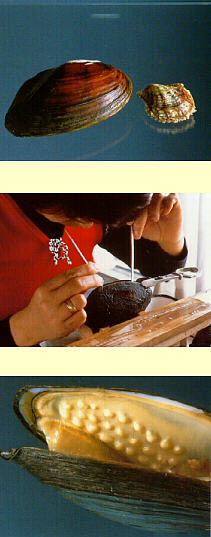
 |
![]()
Freshwater cultured pearl may usually be distinguished from an Akoya or South Sea cultured
pearl by its smaller average size, irregular shape and wider range of coloration.
In the thirteenth century, the Chinese first discovered that pearls could be cultivated using
freshwater mussels. Mud, wood, bone and metal were employed as irritants to stimulate production.
These techniques were attempted in Japan but it was not until 1924 that the Japanese
experienced any marked degree of success. By 1930 they were exporting to India, China and England.
Cultivating Freshwater pearls without the aid of a nucleus began in 1946. Since then, technology has
enhanced yields and brought these pearls worldwide popularity.
 Japanese Freshwater pearls are cultivated primarily in Lake Biwa, near Kyoto. However, due to deteriorating water conditions, both the quality and quantity of Biwa cultured pearls have seriously declined. China, nowadays, produces the largest volume.
Japanese Freshwater pearls are cultivated primarily in Lake Biwa, near Kyoto. However, due to deteriorating water conditions, both the quality and quantity of Biwa cultured pearls have seriously declined. China, nowadays, produces the largest volume.
The mother mussels are called Ikecho, or hyriopsis schlegeli. They are much larger than Akoya oysters and after some fifteen years grow up to a length of 30cm and a width of 20cm.
Cultured pearl oysters from the sea are always seeded with both a piece of mantle tissue and a nucleus. But production of Freshwater pearls, if under 8mm, requires only the insertion of specks of mantle.
Suspended in cages at depths of 2m to 3m, the mussel is tended for three years until ready for its first harvesting. Ikecho mussels may be harvested a second or even a third time. There is no follow-up operation: the pearl sacs that were stimulated by the first operation are simply allowed to produce again. In the second harvesting, the mussel generally provides fewer pearls which are somewhat flatter in shape but which often have better luster and color. Growth slows and quality declines for the few mussels harvested a third time.
Today's Freshwater pearl crops consist mainly of the smaller sizes, ranging from about 2mm to 5mm. The larger, irregular shapes known as crosses, doublets, triplets, sticks and dragons have become virtually extinct. The color ranges, too, are not as wide as before. Shades of white, pink, cream and light-to-dark orange predominate.
The usual criteria of size, shape, color, luster and cleanliness of the surface apply to the valuation of Freshwater cultured pearls.
There is no denying their widespread appeal as their variety allows designers and
craftsmen to create exclusive, unique pieces of jewelry to suit many moods and settings.
